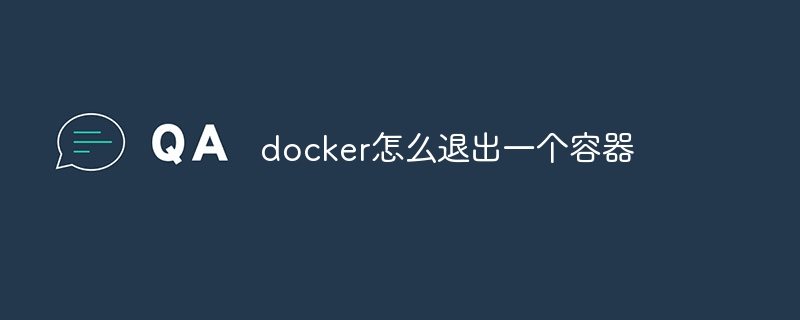How to exit a container by docker
The methods to exit the Docker container are: use the Docker CLI exit command (docker stop), send a SIGTERM signal to the container and wait for 10 seconds before exiting. Exit the container through the Docker API, use POST requests and specify the Stop parameter to true. Force exit from the container (docker stop -t 0), close the container immediately دون and send the SIGTERM signal.

Exit the Docker container
To exit the Docker container, you can use the following methods:
- Exit command using the Docker CLI
You can use the docker stop command followed by the container's ID or name:
1 |
|
- Exit command using the Docker API
You can also exit the container through the Docker API. Use the following cURL command:
1 |
|
Note: The docker stop command will send a SIGTERM signal to the container. If you want to close the container immediately, you can use the docker kill command.
Exit container details
- Exit now (docker kill): Use the
docker killcommand, followed by the container's ID or name, and the container will be closed immediately without sending a SIGTERM signal:
1 |
|
- Docker stop: Using the
docker stopcommand will send a SIGTERM signal to the container, giving the container time to perform any necessary cleaning operations. The container will exit within 10 seconds after receiving the SIGTERM signal. - Force exit (docker stop -t 0): By specifying the
-t 0option to thedocker stopcommand, you can close the container immediately without sending a SIGTERM signal.
Opt-out method
The opt-out method depends on your specific needs:
- Elegantly Exit: If you want the container to perform any cleaning operations before exiting, use the
docker stopcommand. - Exit now: If you want the container to be closed immediately, use the
docker killcommand. - Force Exit: If you want the container to close immediately without performing any cleaning operations, use
docker stop -t 0command.
The above is the detailed content of How to exit a container by docker. For more information, please follow other related articles on the PHP Chinese website!

Hot AI Tools

Undresser.AI Undress
AI-powered app for creating realistic nude photos

AI Clothes Remover
Online AI tool for removing clothes from photos.

Undress AI Tool
Undress images for free

Clothoff.io
AI clothes remover

Video Face Swap
Swap faces in any video effortlessly with our completely free AI face swap tool!

Hot Article

Hot Tools

Notepad++7.3.1
Easy-to-use and free code editor

SublimeText3 Chinese version
Chinese version, very easy to use

Zend Studio 13.0.1
Powerful PHP integrated development environment

Dreamweaver CS6
Visual web development tools

SublimeText3 Mac version
God-level code editing software (SublimeText3)

Hot Topics
 How to exit the container by docker
Apr 15, 2025 pm 12:15 PM
How to exit the container by docker
Apr 15, 2025 pm 12:15 PM
Four ways to exit Docker container: Use Ctrl D in the container terminal Enter exit command in the container terminal Use docker stop <container_name> Command Use docker kill <container_name> command in the host terminal (force exit)
 How to copy files in docker to outside
Apr 15, 2025 pm 12:12 PM
How to copy files in docker to outside
Apr 15, 2025 pm 12:12 PM
Methods for copying files to external hosts in Docker: Use the docker cp command: Execute docker cp [Options] <Container Path> <Host Path>. Using data volumes: Create a directory on the host, and use the -v parameter to mount the directory into the container when creating the container to achieve bidirectional file synchronization.
 How to restart docker
Apr 15, 2025 pm 12:06 PM
How to restart docker
Apr 15, 2025 pm 12:06 PM
How to restart the Docker container: get the container ID (docker ps); stop the container (docker stop <container_id>); start the container (docker start <container_id>); verify that the restart is successful (docker ps). Other methods: Docker Compose (docker-compose restart) or Docker API (see Docker documentation).
 How to check the name of the docker container
Apr 15, 2025 pm 12:21 PM
How to check the name of the docker container
Apr 15, 2025 pm 12:21 PM
You can query the Docker container name by following the steps: List all containers (docker ps). Filter the container list (using the grep command). Gets the container name (located in the "NAMES" column).
 How to start mysql by docker
Apr 15, 2025 pm 12:09 PM
How to start mysql by docker
Apr 15, 2025 pm 12:09 PM
The process of starting MySQL in Docker consists of the following steps: Pull the MySQL image to create and start the container, set the root user password, and map the port verification connection Create the database and the user grants all permissions to the database
 How to start containers by docker
Apr 15, 2025 pm 12:27 PM
How to start containers by docker
Apr 15, 2025 pm 12:27 PM
Docker container startup steps: Pull the container image: Run "docker pull [mirror name]". Create a container: Use "docker create [options] [mirror name] [commands and parameters]". Start the container: Execute "docker start [Container name or ID]". Check container status: Verify that the container is running with "docker ps".
 How to update the image of docker
Apr 15, 2025 pm 12:03 PM
How to update the image of docker
Apr 15, 2025 pm 12:03 PM
The steps to update a Docker image are as follows: Pull the latest image tag New image Delete the old image for a specific tag (optional) Restart the container (if needed)
 How to view logs from docker
Apr 15, 2025 pm 12:24 PM
How to view logs from docker
Apr 15, 2025 pm 12:24 PM
The methods to view Docker logs include: using the docker logs command, for example: docker logs CONTAINER_NAME Use the docker exec command to run /bin/sh and view the log file, for example: docker exec -it CONTAINER_NAME /bin/sh ; cat /var/log/CONTAINER_NAME.log Use the docker-compose logs command of Docker Compose, for example: docker-compose -f docker-com






